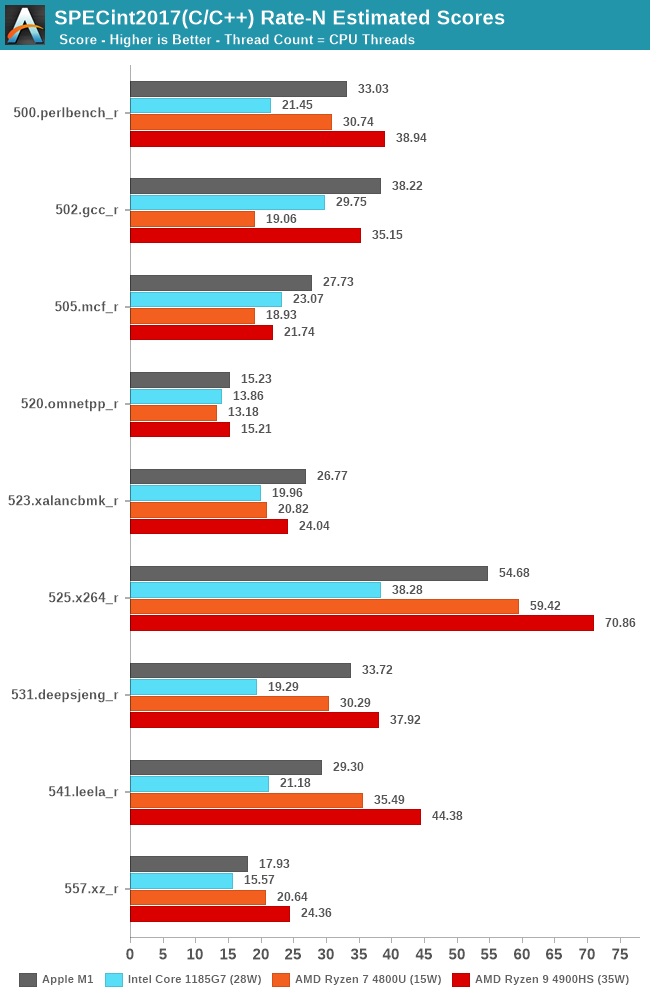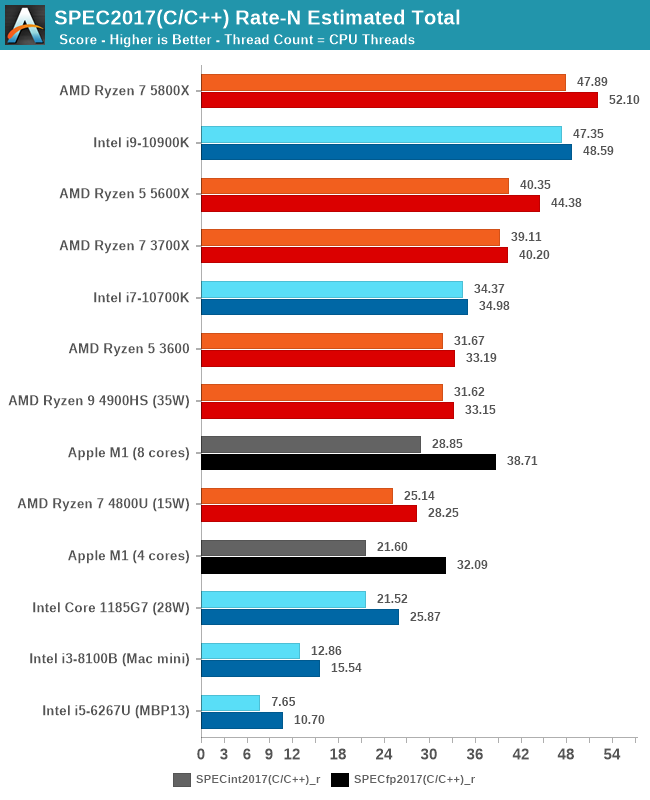The 2020 Mac Mini Unleashed: Putting Apple Silicon M1 To The Test
by Andrei Frumusanu on November 17, 2020 9:00 AM ESTSPEC2017 - Multi-Core Performance
While we knew that the Apple M1 would do extremely well in single-threaded performance, the design’s strengths are also in its power-efficiency which should directly translate to exceptionally good multi-threaded performance in power limited designs. We noted that although Apple doesn’t really publish any TDP figure, we estimate that the M1 here in the Mac mini behaves like a 20-24W TDP chip.
We’re including Intel’s newest Tiger Lake system with an i7-1185G7 at 28W, an AMD Ryzen 7 4800U at 15W, and a Ryzen 9 4900HS at 35W as comparison points. It’s to be noted that the actual power consumption of these devices should exceed that of their advertised TDPs, as it doesn’t account for DRAM or VRMs.

In SPECint2017 rate, the Apple M1 battles with AMD’s chipsets, with the results differing depending on the workload, sometimes winning, sometimes losing.

In the fp2017 rate results, we see similar results, with the Apple M1 battling it out with AMD’s higher-end laptop chip, able to beat the lower TDP part and clearly stay ahead of Intel’s design.

In the overall multi-core scores, the Apple M1 is extremely impressive. On integer workloads, it still seems that AMD’s more recent Renoir-based designs beat the M1 in performance, but only in the integer workloads and at a notably higher TDP and power consumption.
Apple’s lead against Intel’s Tiger Lake SoC at 28W here is indisputable, and shows the reason as to why Apple chose to abandon their long-term silicon partner of 15 years. The M1 not only beats the best Intel has to offer in this market-segment, but does so at less power.
I also included multi-threaded scores of the M1 when ignoring the 4 efficiency cores of the system. Here although it’s an “8-core” design, the heterogeneous nature of the CPUs means that performance is lop-sided towards the big cores. That doesn’t mean that the efficiency cores are absolutely weak: Using them still increases total throughput by 20-33%, depending on the workload, favouring compute-heavy tasks.
Overall, Apple doesn’t just deliver a viable silicon alternative to AMD and Intel, but actually something that’s well outperforms them both in absolute performance as well as power efficiency. Naturally, in higher power-level, higher-core count systems, the M1 can’t keep up to AMD and Intel designs, but that’s something Apple likely will want to address with subsequent designs in that category over the next 2 years.










682 Comments
View All Comments
Ppietra - Friday, November 27, 2020 - link
ARM was really founded as a joint venture between Apple, Acorn and another company.The technology behind it was based on technology from Acorn, but the company was established as a joint venture to develop the processor for Newton. That was the objective for the company creation.
darwinosx - Wednesday, November 18, 2020 - link
Money talks and bullshit walks.lilmoe - Tuesday, November 17, 2020 - link
Not sure how you came to this conclusion with such a poor and unprofessional review. It seemed to me that AMD is killing it on all fronts, but the folks here made it really hard to tell with all these purposefully misleading charts.AMD wins. Come 5nm with Zen4 on laptops, poof goes all the drivel currently in the tech media.
It's disappointing to see this from Andre non-the-less. Very poor quality, and very misleading benchmarks.
ws3 - Tuesday, November 17, 2020 - link
Stage One: denialHifihedgehog - Tuesday, November 17, 2020 - link
Stage One: Comparing Apples to Apples, or 5nm to 5nm. AMD 7nm Zen 2, not even their latest and greatest, is doing admirably against a 5nm product. Pit Zen 3, still held back by 7nm, against it which is a good deal faster than Zen 2 and you have a totally different outcome. Pit Zen 4 where the Zen microarchitecture is given the legs to run with 5nm and it's no contest.defferoo - Tuesday, November 17, 2020 - link
show me a 5nm Zen 4 CPU to test against then, oh, it doesn't exist. I guess we can't do that comparison yet. what matters here is availability, and Zen 4 won't come for another year, M1 is here now.the closest thing to apples to apples now is to use the same TDP for comparison. stack up the Ryzen 7 4800U against the M1 in a Macbook Pro (~15W). M1 is faster in both ST and MT despite the 4800U having 8 cores with SMT.
when AMD was kicking Intel's butt on the 7nm process and Intel was on 14nm, nobody said, "but you need to compare like to like!" except for Intel fans. now it's Intel/AMD vs. Apple, and only those in denial are demanding a fair comparison on the same process node.
YesYesNo - Tuesday, November 17, 2020 - link
I don't see the M1 having faster multicore than the 4800U, which benchmark am i missing?Kuhar - Wednesday, November 18, 2020 - link
You are absolutely right! All that hype around M1 was just overexaggerated.defferoo - Wednesday, November 18, 2020 - link
Spec2017 MT in this very article, Geekbench. We should not over index on one very specific benchmark (Cinebench r23) when we have more comprehensive ways to measure performance.halo37253 - Tuesday, November 17, 2020 - link
Actually the Ryzen 4800U is not only beating the M1 in MultiThread in cinebench. But doing so with similar power usage. This is Zen2. Zen 3 will easily compete with apple silicon in terms of performance/watt, and in most cases beat it. At 7nm no less. Only makes we wonder why Apple is so willing to fracture their already pretty small Mac OS fanbase.The 4800U in 15w mode uses around 20-25watts of power running cinebench, vs the m1 using around 22watts. Sure it doesn't have the lead in single thread performance, but pretty close when the m1 is running x86 apps. Zen3 as we know is a massive improvement in this area. And the 4800U single thread wise is largely clock limited to keep it in check power usage wise.
I just dont see apple beating out AMD any time soon.
The 4800u still uses GCN graphic cores, so expect a huge gain when they move up to RDNA or RDNA2 (Hopefully they jump to 2).
Apple does have years of experience building tightly integrated SOCs, and this is where this chip shines. It clearly shows how well ARM can perform. But this is about as cutting edge as apple has been able to get their chip. AMD's focus is still mostly on the data center, so the fact their mobile devices do so well is a testament to how well suited Zen is to scale down.
Geekbench is a joke of a benchmark and was only ever good comparing devices in the same family. There is wide score changes with the same hardware when taking into the OS its running on. Never use it to compare different CPU Archs or even two different operation systems.